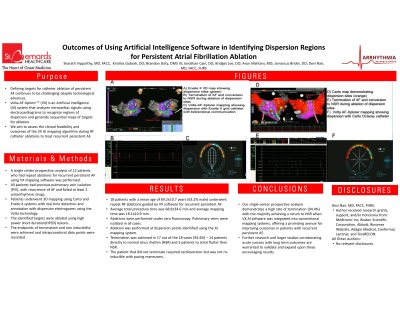Cardiac: Other
Outcomes of Using Artificial Intelligence Software in Identifying Dispersion Regions for Persistent AF Ablation

Kirollos Gabrah, DO – RESIDENT PHYSICIAN, INTERNAL MEDICINE, ST BERNARDS HEART AND VASCULAR; brandon Doty, OMS – Medical Student, NYITCOM; Johnathan Cain, DO – RESIDENT PHYSICIAN, INTERNAL MEDICINE, ST BERNARDS HEART AND VASCULAR; Bridget Lee, DO – RESIDENT PHYSICIAN, INTERNAL MEDICINE, ST BERNARDS HEART AND VASCULAR; Arun Mahtani, MD – RESIDENT PHYSICIAN, INTERNAL MEDICINE, NYU; Jamarcus Brider, DO – RESIDENT PHYSICIAN, INTERNAL MEDICINE, ST BERNARDS HEART AND VASCULAR; Devi Nair, MD, FACC, FHRS – Attending Electrophysiologist, Electrophysiology, ST BERNARDS HEART AND VASCULAR
Purpose: Defining targets for catheter ablation of persistent AF continues to be challenging despite technological advances. Volta AF-Xplorer™ (VX) is an Artificial intelligence (AI) system that analyzes intracardiac signals using electrocardiograms to recognize regions of dispersion and generate sequential maps of targets for ablation. We aim to assess the clinical feasibility and outcomes of the VX AI mapping algorithm during RF catheter ablations to treat recurrent persistent AF.
Material and Methods: A single center prospective analysis of 12 patients who had repeat ablations for recurrent persistent AF using VX mapping software was performed. All patients had previous pulmonary vein isolation (PVI), with recurrence of AF and failed at least 2 antiarrhythmic drugs. Patients underwent 3D mapping using Carto and Ensite X systems with real time detection and annotation with dispersion electrograms using the Volta technology. The identified targets were ablated using high power short duration(HPSD) lesions. The endpoints of termination and non inducibility were achieved and intraprocedural data points were recorded.
Results: 18 patients with a mean age of 69.2±10.7 years (63.2% male) underwent repeat RF ablations guided by VX software for recurrent persistent AF. Average total procedure time was 68.8±34.6 min and average mapping time was 18.1±10.9 min. Ablations were performed under zero fluoroscopy. Pulmonary veins were isolated in all cases. Ablation was performed at dispersion points identified using the AI mapping system. Termination was achieved in 17 out of the 18 cases (94.4%) – 14 patients directly to normal sinus rhythm (NSR) and 3 patients to atrial flutter then NSR. The patient that did not terminate required cardioversion but was not re-inducible with pacing maneuvers.
Conclusions: Our single-center prospective analysis demonstrates a high rate of termination (94.4%) with the majority achieving a return to NSR when VX AI software was integrated into conventional mapping systems, offering a promising avenue for improving outcomes in patients with recurrent persistent AF. Further research and larger studies corroborating acute success with long term outcomes are warranted to validate and expand upon these encouraging results.
Material and Methods: A single center prospective analysis of 12 patients who had repeat ablations for recurrent persistent AF using VX mapping software was performed. All patients had previous pulmonary vein isolation (PVI), with recurrence of AF and failed at least 2 antiarrhythmic drugs. Patients underwent 3D mapping using Carto and Ensite X systems with real time detection and annotation with dispersion electrograms using the Volta technology. The identified targets were ablated using high power short duration(HPSD) lesions. The endpoints of termination and non inducibility were achieved and intraprocedural data points were recorded.
Results: 18 patients with a mean age of 69.2±10.7 years (63.2% male) underwent repeat RF ablations guided by VX software for recurrent persistent AF. Average total procedure time was 68.8±34.6 min and average mapping time was 18.1±10.9 min. Ablations were performed under zero fluoroscopy. Pulmonary veins were isolated in all cases. Ablation was performed at dispersion points identified using the AI mapping system. Termination was achieved in 17 out of the 18 cases (94.4%) – 14 patients directly to normal sinus rhythm (NSR) and 3 patients to atrial flutter then NSR. The patient that did not terminate required cardioversion but was not re-inducible with pacing maneuvers.
Conclusions: Our single-center prospective analysis demonstrates a high rate of termination (94.4%) with the majority achieving a return to NSR when VX AI software was integrated into conventional mapping systems, offering a promising avenue for improving outcomes in patients with recurrent persistent AF. Further research and larger studies corroborating acute success with long term outcomes are warranted to validate and expand upon these encouraging results.
